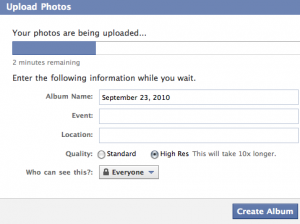
Recently, I wrote an article about Flickr reaching the five billionth photo milestone. What I didn’t mention in that article was how Facebook is seeing monthly photo uploads at 2.5 times the pace of Flickr’s annual uploads. That’s right… Facebook users upload approximately 2.5 billion photos per month. With that many photos circulating the Facebook community, it’s no wonder that the social media giant has just decided to roll out some new features regarding user photos.
Hi-Res Images
Facebook has always been a place where users can share quick snapshots of their lives, usually taken with point-and-shoot cameras or mobile devices. After all, most people don’t even own a dSLR. The standard resolution for Facebook photos is currently 720 pixels, so you can see why it’s a big deal that they’ve just upped the resolution to a whopping 2048 pixels.

Users will now have the option to upload images in either standard or high-res quality. But that’s not all. There will also be a “download” button located underneath each photo, allowing users to download any of these high-res images in JPG format. Before, anyone with half a brain could have just as easily right clicked and saved as, but this extra button makes it that much easier for people to download your photos.
Light Boxes
While increasing resolution to 2048 pixels already does wonders for the quality of user photos, Facebook has gone one step further and will be implementing “light boxes” as well. This means that every time you click on an image, the photo will load on top of a darkened version of the content you were looking at, giving each photograph (especially the high res ones) an elegant feel.

Tagging
Another feature that Facebook will be implementing is bulk tagging. Currently, you can tag a friend in a photo, but each image must be tagged individually. Bulk tagging is just what it sounds like. Now, you’ll be able to view a list of thumbnails of all the pictures in an album where you can tag your cousin Larry’s goofy mug in multiple pictures, all at the same time. This definitely makes tagging less of a hassle and much more efficient.
Flash Uploader
Last, but not least, Facebook will now use a Flash-based uploader when adding pictures. This should increase reliability and speed. Users with newer computers and fast internet speeds may not see much of a difference, but it should be noticeable to those with older computers and crummy connections.
How does this affect photographers?
Well, you’ve probably heard this many times over the last year or two, but Facebook isn’t quite the ideal place for photographers to set up their portfolios anyway. Their terms of service have a history of not being entirely photographer-friendly (although they have improved a bit), but allowing users to upload high-res versions of their photos sounds like trouble to me.
Of course, if you only have a small tight-knit group of friends on Facebook, then realistically you don’t have much to worry about. Personally, I feel safe in saying that my friends don’t quite have an interest in “stealing” my pictures so they can sell or misuse them in any way whatsoever.
But like any other online community, a photographer always takes a risk simply by uploading his or her work, whether it be Facebook or Flickr. There’s always going to be that slight chance, and the only way to prevent it is to not put any of your work online at all. Strong arguments for either side can be made, and I’m sure this topic will be up for some heated debate. It will definitely be interesting to see how this plays out over the next few weeks as Facebook rolls out its new features to the rest of the planet.
(via Inside Facebook)










